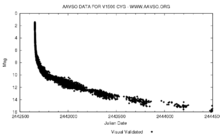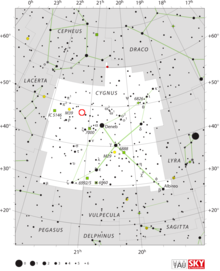
V1500 Cygni or Nova Cygni 1975 was a bright nova occurring in 1975 in the constellation Cygnus. It had the second highest intrinsic brightness of any nova of the 20th century, exceeded only by CP Puppis in 1942.[10]
V1500 Cygni was discovered shining at an apparent brightness of magnitude 3.0 by Minoru Honda of Kurashiki, Japan on 29 August 1975.[11] It had brightened to magnitude 1.7 on the next day, and then rapidly faded. It remained visible to the naked eye for about a week, and 680 days after reaching maximum the star had dimmed by 12.5 magnitudes.

It is an AM Herculis type star, consisting of a red dwarf secondary depositing a stream of material onto a highly magnetized white dwarf primary. The distance of the V1500 Cygni was calculated in 1977 by the McDonald Observatory at 1.95 kiloparsecs (6,360 light years).[12] More recently the Gaia space observatory determined a distance of approximately 5,100 light years.[1] Additionally, V1500 Cyg was the first asynchronous polar to be discovered. This distinction refers to the fact that the white dwarf's spin period is slightly different from the binary orbital period. [13] However, by 2016, x-ray observations strongly suggested that the white dwarf rotation had returned to normal synchronization with the orbit.[4]
V1500 Cygni has a remnant typical of very fast novae, consisting of some clumps and some spherically symmetric diffuse material.[14]
See also
References
- ^ a b c d e Vallenari, A.; et al. (Gaia collaboration) (2023). "Gaia Data Release 3. Summary of the content and survey properties". Astronomy and Astrophysics. 674: A1. arXiv:2208.00211. Bibcode:2023A&A...674A...1G. doi:10.1051/0004-6361/202243940. S2CID 244398875. Gaia DR3 record for this source at VizieR.
- ^ a b Samus, N. N.; Durlevich, O. V.; et al. (2009). "VizieR Online Data Catalog: General Catalogue of Variable Stars (Samus+ 2007-2013)". VizieR On-line Data Catalog: B/GCVS. Originally Published in: 2009yCat....102025S. 1: B/gcvs. Bibcode:2009yCat....102025S.
- ^ Pavlenko, E. P.; Mason, P. A.; Sosnovskij, A. A.; Shugarov, S. Yu; Babina, Ju V.; Antonyuk, K. A.; Andreev, M. V.; Pit, N. V.; Antonyuk, O. I.; Baklanov, A. V. (2018). "Asynchronous polar V1500 Cyg: Orbital, spin, and beat periods". Monthly Notices of the Royal Astronomical Society. 479 (1): 341. arXiv:1806.03610. Bibcode:2018MNRAS.479..341P. doi:10.1093/mnras/sty1494. S2CID 119083203.
- ^ a b Harrison, Thomas E.; Campbell, Ryan K. (2016). "The apparent synchronization of V1500 Cygni". Monthly Notices of the Royal Astronomical Society. 459 (4): 4161. Bibcode:2016MNRAS.459.4161H. doi:10.1093/mnras/stw961.
- ^ a b c d Harrison, Thomas E.; Campbell, Ryan K. (2018). "The detection of discrete cyclotron emission features in phase-resolved optical spectroscopy of V1500 Cygni". Monthly Notices of the Royal Astronomical Society. 474 (2): 1572. arXiv:1711.01220. Bibcode:2018MNRAS.474.1572H. doi:10.1093/mnras/stx2881. S2CID 118920468.
- ^ Hachisu, Izumi; Kato, Mariko (2019). "A Light-curve Analysis of 32 Recent Galactic Novae: Distances and White Dwarf Masses". The Astrophysical Journal Supplement Series. 242 (2): 18. arXiv:1905.10655. Bibcode:2019ApJS..242...18H. doi:10.3847/1538-4365/ab1b43. S2CID 166228785.
- ^ a b Schmidt, Gary D.; Liebert, James; Stockman, H. S. (1995). "Detection of the Hot White Dwarf in the Magnetic Nova V1500 Cygni with the Hubble Space Telescope". The Astrophysical Journal. 441: 414. Bibcode:1995ApJ...441..414S. doi:10.1086/175365.
- ^ Wang, Qishan; Qian, Shengbang; Liao, Wenping (1 November 2021). "Photometric Analysis of the TESS Light Curve for the Asynchronous Polar V1500 Cyg". Publications of the Astronomical Society of the Pacific. 133 (1029) 114201. Bibcode:2021PASP..133k4201W. doi:10.1088/1538-3873/ac27f9.
- ^ "V1500 Cyg". SIMBAD. Centre de données astronomiques de Strasbourg. Retrieved 2023-03-05.
- ^ "V1500 Cyg (Nova Cygni 1975)". American Association of Variable Star Observers. Retrieved 2019-10-31.
- ^ "V1500 Cyg (Nova Cygni 1975)". AAVSO. Retrieved 29 November 2020.
- ^ Ferland, G. J. (1977). "The interstellar reddening and distance of Nova Cygni 1975 /V1500 Cygni/". Astrophysical Journal. 215: 873. Bibcode:1977ApJ...215..873F. doi:10.1086/155424.
- ^ Stockman, H. S.; Schmidt, Gary D.; Lamb, D. Q. (1988). "V1500 Cygni - Discovery of a magnetic nova". The Astrophysical Journal. 332: 282. Bibcode:1988ApJ...332..282S. doi:10.1086/166652.
- ^ Lloyd, H.M.; O'Brien, T.J.; Bode, M.F. (1997). "Shaping of nova remnants by binary motion" (PDF). Monthly Notices of the Royal Astronomical Society. 284 (1): 137–147 [146]. Bibcode:1997MNRAS.284..137L. doi:10.1093/mnras/284.1.137.
Further reading
- Ferland GJ; Tomkin J; Woodman J (1976). "Continuum variability in Nova Cygni 1975". Nature. 264 (5587): 627–9. Bibcode:1976Natur.264..627F. doi:10.1038/264627a0. S2CID 4258059.
External links
- "Detail for V1500 Cygni". The International Variable Star Index. Retrieved 2008-09-09.
- "Nova Cygni 1975 (V1500 Cygni)". The Encyclopedia of Astrobiology, Astronomy and Spaceflight. Retrieved 2005-08-12.
- "V1500 Cyg (Nova Cygni 1975)". American Association of Variable Star Observers. Retrieved 2010-08-29.









You must be logged in to post a comment.